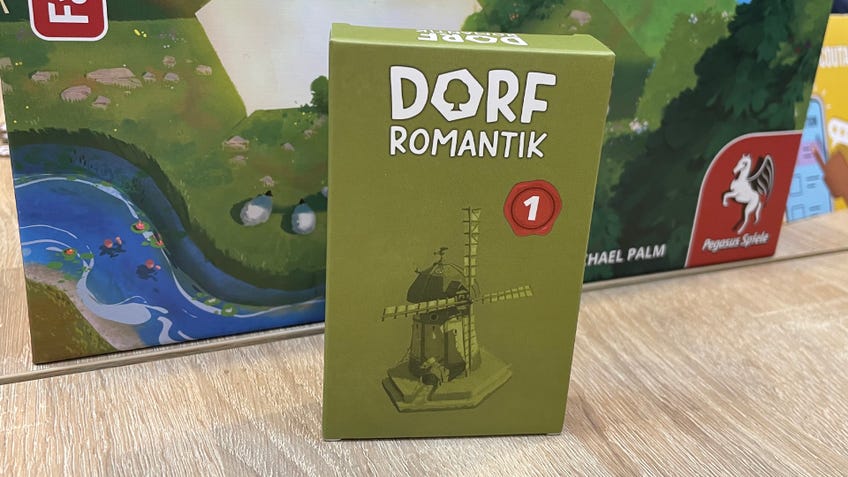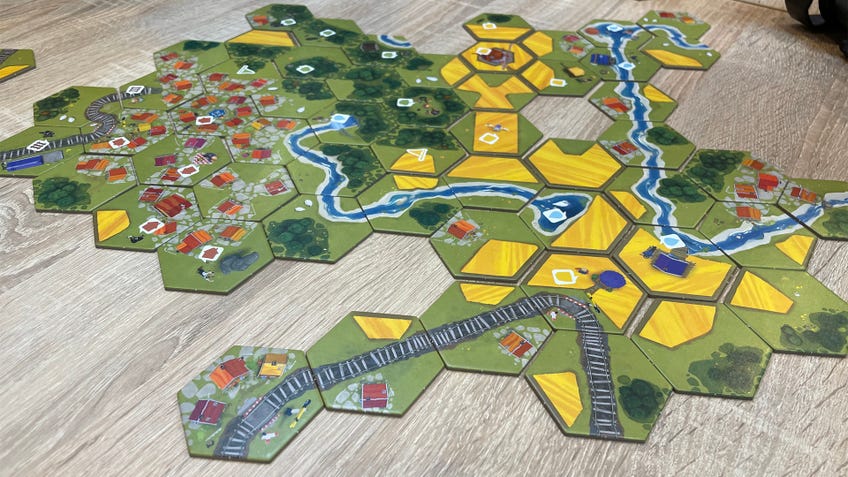Dorfromantik: The Board Game is just as chill and charming as the video game, but you can now play with friends - Essen Spiel 2022 preview
Exactly what you’d hex-pect.
The circle (or should that be hex?) is complete. Board game-inspired video game Dorfromantik has traded its digital tiles for cardboard ones in Dorfromantik: The Board Game.
For the uninitiated: Dorfromanik is a video game in which the player plonks down hexagonal tiles on a virtual table. Each tile represents a slice of a landscape built by the player, featuring one or more geographical features: villages, forests, rivers, train tracks, fields of grain.
As tiles are added to the ever-sprawling vista, some tiles throw up specific challenges for the player to complete in return for bonus points. You might need to connect 10 sections of train track together, surround a windmill with yellow fields or grow a couple of houses into a miniature town. When the stack of tiles runs out, you tot up your final score.
If you hadn’t guessed yet, Dorfromantik isn’t a high-octane action game or even an especially head-scratching puzzler. There are ways to optimise your tiles as they’re placed, but you’re never especially punished for just going with your gut - or just arranging things so they look nice. (Everything looks nice in this game.) Score-chasers can push for ruthless efficiency in every hex, while others can just take satisfaction in watching their little world come to life.
For those thinking “That’s nice and all, but I’d love to play this as a real board game”, good news: Dorformantik: The Board Game is here, and it’s faithful to its video game counterpart down to a chill, cutesy T.
Dorfromantik: The Board Game is faithful to its video game counterpart down to a chill, cutesy T.
Dorfromantik works on the tabletop almost identically to its virtual cousin, except now a group of friends can build their adorable diorama together. (If you prefer to play alone, a solo mode is also included.)
Up to six people take turns to add a tile to the spreading tableau, arranging each hex to ideally group villages, forests and fields together for maximum points - with rivers and train tracks needing to extend any existing networks already placed.

Separate mission tiles present objectives like those in the video game, requesting a certain number of joined regions, tracks or rivers to be scored. Whenever there are fewer than three mission tiles on the board (unfulfilled goals are marked by tokens), the next player adds one. Meanwhile, flag tiles score extra points when surrounded, adding bonus points for connected groups of matching terrain, and points are added for the longest river and track at the end of the game.
And so it goes as before, with players working their way through the stack before they calculate their total score - although this time you’ll have to do the maths yourself on a scorepad.
Our time playing the standard game mode during a demo at Essen Spiel 2022 confirmed what many had assumed: Dorfromantik is a natural fit for a cardboard remake, comfortably sliding onto the tabletop with few surprises or unnecessary bells and whistles. The game’s artwork looks just as charming and clear in 2D as it does in 3D - no need for a box of overpriced plastic windmill miniatures - and its simple rules will feel instantly familiar to fans of the original without taking more than a couple of minutes to pick up for newcomers.

It’s not that there are zero surprises, however. Once you’ve got to grips with the basic rules, Dorfromantik: The Board Game includes a short campaign mode contained in five numbered packages inside the box.
It’s easy to imagine playing a complete campaign in an evening and coming away feeling like you’ve taken a big breath of fresh countryside air.
Each box is unlocked through a dedicated campaign sheet, with players recording their progress after each game and using their score and achievements to move along a set of branching paths. Along each path are a set of unlockables that add new tiles, rules and objectives to the game.
While our demo didn’t extend to seeing what box 1 held, our roughly 30-minute learning game with four players scored us more than enough points to unlock the first package and progress us most of the way towards a second unlock. The entire campaign will be replayable and resettable, with the option to unlock a different set of tiles on successive playthroughs.
Like the video game, Dorfromantik: The Board Game is a relaxed, satisfying experience from beginning to end. One game breezed by; it’s easy to imagine playing a complete campaign in an evening and coming away feeling like you’ve taken a big breath of fresh countryside air.
There’s enough cooperative puzzle here to make where you place a tile feel meaningful and encourage conversation around the table, without interrupting the calming atmosphere that made the video game an instant hit. Trying to command others to maximise your score isn’t necessary to progress at a pleasing rate, and will likely go down like a wet fart in a hushed library.
If you’re already fallen hard for the video game, the Dorfromantik board game will give you exactly what you expect: more of the same away from a screen, with the added appeal of placing real tiles, opening boxes and playing with friends. For those who are new, this is the ideal introduction to a peaceful, inviting world of your own making.
Dorfromantik: The Board Game will be released in English in 2023.


